Practicing the Bridges in Mathematics Grade 4 Home Connections Answer Key Unit 3 Module 1 will help students analyze their level of preparation.
Bridges in Mathematics Grade 4 Home Connections Answer Key Unit 3 Module 1
Bridges in Mathematics Grade 4 Home Connections Unit 3 Module 1 Session 2 Answer Key
Skills Review
Question 1.
Did you know that there are 14 Life Saver candies in a roll of Life Savers? Fill in the blanks on the ratio table to show how many Life Savers there are in different numbers of rolls.

Answer:
I have filled in the blanks on the ratio table and shown how many Life Savers there are in different numbers of rolls.
Explanation:

Question 2.
When people play a game of pool, they often use 15 numbered balls and 1 cue ball for a total of 16 balls. Fill in the blanks on the ratio table to show how many balls there are in different numbers of sets.
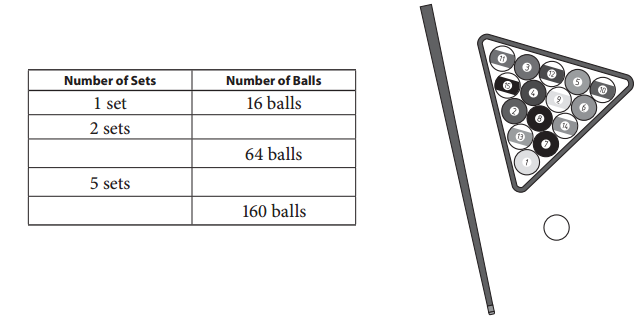
Answer:
I have filled in the blanks on the ratio table to show how many balls there are in different numbers of sets.
Explanation:

Question 3.
List all the factor pairs for the number 36.
Answer:
The pair factors of 36 are (1, 36), (2, 18), (3, 12), (4, 9), and (6, 6).
Explanation:
The list of factor pairs for the number 36 are
1 × 36 = 36
2 × 18 = 36
3 × 12 = 36
4 × 9 = 36
6 × 6 = 36
Question 4.
List all the factor pairs for the number 42.
Answer:
The factors of 42 in pairs are (1, 42), (2, 21), (3, 14), and (6, 7).
Explanation:
The list of factor pairs for the number 42 are
1 x 42 = 42
2 x 21 = 42
3 x 14 = 42
6 x 7 = 42
Question 5.
Bryce has a rug that is 14 decimeters by 16 decimeters. Draw a sketch of Bryce’s rug. Then find the area of his rug. Show your work and label the answer with the correct units.
Answer:
The area of the rug is 224 square decimeters.
Explanation:
Given,
Length = 16 decimeters
Width = 14 decimeters.
Area of the rectangle = L × W
Area = 16 × 14
= 224 square decimeters.
Question 6.
Kim’s bedroom is 13 feet long and 11 feet wide. Draw a sketch of Kim’s bedroom floor. Then find the area of Kim’s bedroom. Show your work and label the answer with the correct units.
Answer:
The area of Kim’s bedroom is 143 square feet.
Explanation:
Given,
Length = 13 feet
Width = 11 feet
Area of the rectangle is = 13 × 11
= 143 square feet
Hence the area of Kim’s bedroom is 143 square feet.
Question 7.
CHALLENGE Ella and Jade both ran a marathon. Ella finished in 4 hours, 6 minutes, and 13 seconds. Jade finished in 4 hours, 3 minutes, and 18 seconds. Who was faster? By how many seconds? Show your work and label the answer with the correct units.
Answer:
Jade is faster than Ella by 2 minutes and 55 seconds.
Explanation:
We know that Ella and Jade both ran a marathon.
Ella finished the marathon in 4 hours 6 mins and 13 seconds.
Jade finished the marathon in 4 hours and 3 mins and 18 seconds.
We can write 4 hours 6 minutes 13 seconds as 4 hours 5 minutes 73 seconds. 1 minute has been borrowed to the second’s side, and seconds become 13+60 = 73 seconds.
Now we know that Ella took more time than Jade.
Now let us find how much more time Ella took than Jade by subtracting the time taken by Jade from the time taken by Ella.
4 hours 5 minutes 73 seconds – 4 hours and 3 mins and 18 seconds
= 2 min 55 sec
Bridges in Mathematics Grade 4 Home Connections Unit 3 Module 1 Session 4 Answer Key
Fraction & Division Story Problems
On Tuesday, David and three friends shared a large pizza for an after-school treat. Each of the four boys ate the same amount of pizza. On Thursday, David shared 2 large pizzas with 7 friends from his soccer team. Each of the 8 team members got equal amounts.
Question 1.
Use the circles below to draw labeled models showing how much pizza David got to eat on both days.
a. Tuesday’s Pizza Shares
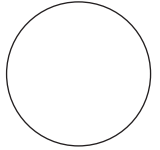
Answer:
David ate \(\frac{1}{4}\) large pizza on Tuesday.
Explanation:

Given,
On Tuesday,
1 large pizza divided among 4 people.
Each person ate \(\frac{1}{4}\) pizza
b. Thursday’s Pizza Shares
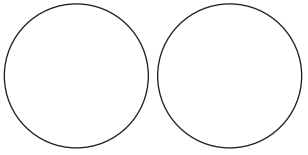
Answer:
David ate \(\frac{1}{4}\) large pizza on Thursday.
Explanation:

Given,
On Thursday,
There are 2 pizzas.
These are divided among 8 people.
So, each person will get = \(\frac{2}{8}\) = \(\frac{1}{4}\)
Hence david ate \(\frac{1}{4}\) large pizza on Thursday.
Question 2.
What fraction of a large pizza did David eat on Tuesday? ________
Answer:
David ate \(\frac{1}{4}\) large pizza on Tuesday.
Explanation:

Question 3.
What fraction of a large pizza did David eat on Thursday? ________
Answer:
David ate \(\frac{1}{4}\) large pizza on Thursday.
Explanation:

Question 4.
Did David eat more pizza on Tuesday or on Thursday? _____________
Answer:
David eats more pizza on Thursday.
Explanation:
On Tuesday David eats 1 large pizza and David plus 3 friends 4 pieces.
Each person ate \(\frac{1}{4}\) large pizza.
On Thursday David ate 2 large pizzas.
8 people
\(\frac{2}{8}\) = \(\frac{1}{4}\)
Hence David ate \(\frac{1}{4}\) large pizza on tuesday.
David ate \(\frac{1}{4}\) large pizza on thursday.
Hence David ate more pizza on Thursday.
Question 5.
Write at least three mathematical observations that you can make from your sketches for this situation.
Answer:
I have written the three mathematical observations that we can make from the sketches for this situation.
Explanation:
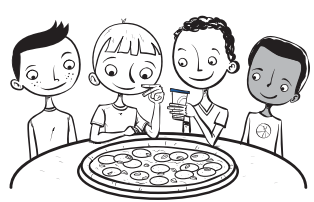
Tuesday 1 large pizza
David and his three friends = 4 pieces.
Each people ate \(\frac{1}{4}\) large pizza
On Thursday 2 large pizza
For 8 people
\(\frac{2}{8}\) = \(\frac{1}{4}\)
Question 6.
Write a story problem to match each of the equations below:
ex 13 ÷ 4 = 3 R1
The gym teacher has 13 playground classrooms to share. How many balls will each classroom get?
a. 13 ÷ 4 = 3 \(\frac{1}{4}\)
Answer:
The story problem we can write about is 4 friends sharing 13 playground classrooms.
Explanation:
The number of balls each classroom gets is 3.
b. 13 ÷ 4 = $3.25
Answer:
If we divide 13 by 4 the answer we get is 3.25.
Explanation:
The number of balls each classroom gets is 3.25 which is approximately 3.
c. 16 ÷ 4 = 4
Answer:
The story problem is 4 friends sharing 16 playground classrooms. The number of balls each classroom gets is 4.
Question 7.
CHALLENGE LaToya had a large collection of basketball cards. She decided to give half of them to her friend, Erin, and a fourth of them to her brother. She still has 75 cards left. How many cards did she start with?

Answer:
The number of cards she starts with is 75 cards.
Explanation:
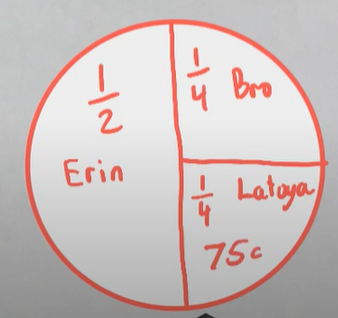
Let the total cards be x.
The number of cars she gives to her friend is \(\frac{x}{2}\).
The number of cars she gives to her friend is \(\frac{x}{4}\).
Total cards she has given
\(\frac{x}{4}\) + \(\frac{x}{2}\)
Total cards = \(\frac{(2x + x)}{4}\)
= \(\frac{3x}{4}\)
The remaining cards will be x – \(\frac{3x}{4}\)
= \(\frac{(4x – 3x)}{4}\)
= \(\frac{x}{4}\)
Number of remaining cards = 75
\(\frac{x}{4}\) = 75
x = 300
Hence, the number of cards she starts with is 75 cards.
Bridges in Mathematics Grade 4 Home Connections Unit 3 Module 1 Session 6 Answer Key
Thinking About Fractions
Question 1.
Rico’s dad brought home two pizzas that were exactly the same size. The pepperoni pizza was cut into 6 equal pieces. The cheese pizza was cut into 12 equal pieces. Rico’s little brother, Luis, ate 2 pieces of pepperoni pizza. His big sister, Carlota, ate 4 pieces of the cheese pizza. Luis started crying because he thought Carlota got more pizza than he did. Carlota said they got exactly the same amount.
a. Who was right, Luis or Carlota? __________
Answer:
Carlota was right.
Explanation:
We know,
The pepperoni pizza was cut into 6 equal pieces. The cheese pizza was cut into 12 equal pieces.
Rico’s little brother, Luis, ate 2 pieces of pepperoni pizza.
His big sister, Carlota, ate 4 pieces of cheese pizza.
Luis started crying because he thought Carlota got more pizza than he did and Carlota said they got exactly the same amount.
what Carlota said is correct because the pepperoni pizza was cut into 6 equal pieces which is 2 times the cheese pizza was cut.
b. Use labeled sketches, numbers, and words to explain your answer. ________
Answer:
We have labeled the sketches with the given information.
Explanation:

Question 2.
Vincent says that \(\frac{1}{4}\) is bigger than \(\frac{1}{3}\) because 4 is more than 3.
a. Do you agree with Vincent?
Answer:
No, I didn’t agree.
Explanation:
\(\frac{1}{4}\) < \(\frac{1}{3}\)
b. Use labeled sketches, numbers, and words to explain your answer.
Answer:

Explanation:
The given number \(\frac{1}{4}\) < \(\frac{1}{3}\)
Question 3.
Talia says that \(\frac{1}{3}\) and \(\frac{2}{6}\) are equivalent fractions.
a. Do you agree with Talia? _______
Answer:
yes, it is true.
Explanation:
The given fractions \(\frac{1}{3}\) and \(\frac{2}{6}\) are equivalent fractions.
b. Use labeled sketches, numbers, and words to explain your answer. (You can use the egg carton diagrams to help if you like.)

Answer:
I used labeled sketches to show \(\frac{1}{3}\) and \(\frac{2}{6}\) are equivalent fractions.
Explanation:

c. Name another fraction that is equivalent to \(\frac{1}{3}\). ________
Answer:
\(\frac{2}{6}\), \(\frac{3}{9}\) anf \(\frac{4}{12}\).
Explanation:
The other fraction is equivalent to \(\frac{1}{3}\) is \(\frac{2}{6}\), \(\frac{3}{9}\) anf \(\frac{4}{12}\).
Question 4.
CHALLENGE In a 12-egg carton, \(\frac{1}{6}\) equals 2 eggs. Use the grids below to help you imagine and draw cartons where:
a. \(\frac{1}{6}\) is 3 eggs.
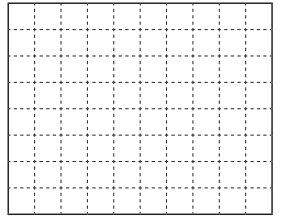
Answer:
There are 18 eggs in a carton.
Explanation:
Given,
\(\frac{1}{6}\) is 3 eggs.
= 18 eggs.
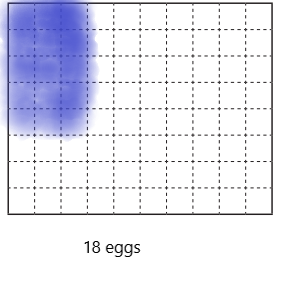
b. \(\frac{5}{6}\) is 25 eggs.

Answer:
There are 30 eggs in a carton.
Explanation:
Given,
\(\frac{5}{6}\) is 25 eggs.
= 30 eggs
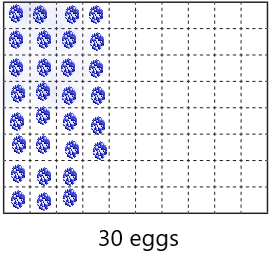
c. How did you decide on the sizes of the cartons for a and b?
Answer:
The size of carton b is greater than the size of carton a.
explanation:
The carton has 18 eggs and carton b has 30 eggs.
By comparing both the size of carton a is greater than b.